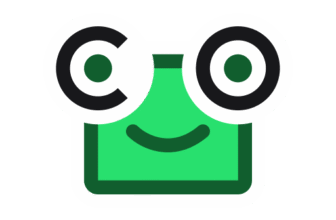
Introduction
Sales forecasting is a staple of revenue planning, but traditional approaches often rely solely on intuition or spreadsheets. CRM sales forecasting combines your customer relationship management system with analytics to predict future sales and revenue with greater accuracy. By capturing interactions, deal stages, and customer behavior in one place, a CRM provides the data foundation for reliable forecasts. Accurate forecasting helps you allocate resources, set realistic targets, and spot risks early. Whether you run a small start‑up or manage an enterprise sales team, understanding how CRM sales forecasting works will empower you to make smarter decisions and create sustainable growth.
What Is CRM Sales Forecasting?
Explanation and definition of CRM sales forecasting
CRM sales forecasting is the practice of using data stored in your customer relationship management system to predict future sales revenue. Your CRM tracks leads, deals, customer interactions, and historical transactions. When you apply analytical models to that data, such as weighted pipeline percentages or regression analysis, you can estimate how much revenue will come in over a specific period. Unlike gut‑driven predictions or static spreadsheets, CRM forecasting uses structured data and repeatable processes to generate objective revenue projections.
A key principle of CRM sales forecasting is data quality. The more accurate and up‑to‑date your CRM records are, the more reliable your forecast will be. Since sales reps often log calls, emails, and deal updates in real time, the CRM becomes a single source of truth. When forecasting, you analyze the probability of deals closing at each stage of your pipeline, examine patterns in win rates by lead source or customer segment, and consider external factors like seasonality or economic trends. Modern CRM platforms often include built‑in forecasting tools that automate these calculations and deliver dashboards with projected revenue, deal risk scores, and pipeline health metrics.
Difference between CRM forecasting and general sales forecasting
General sales forecasting refers to estimating future revenue using any available data, which might include spreadsheets, accounting software, or simple mathematical formulas. CRM sales forecasting, by contrast, leverages the centralized data repository of your CRM. This difference matters because:
- Comprehensive data capture: A CRM stores detailed records of every lead, prospect, and customer interaction. It includes demographic information, communications, deal values, close dates, and sales activities. General forecasting methods might rely on limited or fragmented data, whereas CRM forecasting draws from richer insights.
- Real‑time updates: Since your sales team uses the CRM daily, the data is continuously updated. This keeps forecasts current and reduces the lag time between changes in the pipeline and adjustments in revenue expectations.
- Automation and integration: Most CRM platforms integrate with marketing automation, email, accounting, and customer support tools. Forecasting based on CRM data can incorporate information from across the business, creating a more holistic view. Stand‑alone spreadsheets or accounting tools require manual updates and are more prone to errors.
- Collaboration: CRM forecasts are accessible to all stakeholders, sales reps, managers, finance teams, and executives. This transparency fosters alignment and makes it easier to compare projections with actual results. General forecasting methods often stay siloed within one department.
By grounding your forecasts in CRM data, you gain a clearer, more actionable picture of upcoming revenue and can respond quickly when variables change.

Why CRM Sales Forecasting Matters
Financial planning and budget management
Accurate forecasts inform your budgeting decisions. When you know how much revenue to expect, you can decide whether to invest in new hires, increase your marketing spend or build inventory. Conversely, a downturn in projected sales may signal the need to tighten spending. Forecasting also helps you understand cash flow: by projecting when deals will close and payments will arrive, you can plan for expenses such as salaries, vendor payments, and loan repayments. Without reliable forecasts, businesses risk overstocking inventory, under‑staffing during busy periods or missing growth opportunities because they lack the confidence to invest.
Cross‑departmental benefits: sales, marketing, finance, operations
CRM sales forecasting delivers insights that extend well beyond the sales team:
- Marketing: Marketers can adjust campaigns based on forecasted demand. If your forecast predicts a spike in sales following a product launch or seasonal promotion, marketing can ensure campaigns run at the right time and allocate budget accordingly. Conversely, if the pipeline looks thin, marketing may increase lead‑generation efforts.
- Finance: Finance teams use revenue projections to build budgets, model cash flow and plan capital expenditures. Knowing when revenue will arrive enables them to manage debt, plan tax payments, and assess the financial viability of new projects.
- Operations and supply chain: Forecasts help operations plan production schedules, inventory procurement and staffing levels. For example, an accurate quarterly forecast allows manufacturing to order raw materials and schedule shifts to meet expected demand without excessive overstock.
- Product management: Insights into expected demand inform product roadmaps, feature prioritization and resource allocation for engineering. If forecasts indicate growing demand in a certain market segment, product managers may accelerate relevant features or plan additional releases.
When each department bases its plans on the same forecasting data, the entire organization aligns around shared expectations. This cohesion leads to better resource utilization and fewer surprises.
Key Concepts and Terms
Before diving into methods, it helps to understand key forecasting terminology:
- Sales forecast: An estimate of future revenue over a set period. It’s based on data and assumptions about conversion rates, deal values and market conditions. The forecast answers the question: how much will we sell during a given timeframe?
- Sales quota: A target revenue or number of deals that individual sales reps or teams aim to reach. Quotas are often set using forecasts as a baseline, ensuring they are challenging yet achievable.
- Qualitative forecasting: Methods that rely on human judgment, expert opinions, market research or surveys. These are useful when entering new markets or launching products without historical data.
- Quantitative forecasting: Techniques that use historical data and mathematical models to predict future sales. Examples include time series analysis, regression analysis and moving averages.
- Predictive analytics: Advanced techniques that use machine learning and statistical models to identify patterns in data and predict outcomes. In a CRM context, predictive analytics analyzes variables such as deal size, time in stage, engagement level and market trends to forecast revenue more accurately.
- Funnel stages: The sales funnel represents the journey from lead to customer. Common stages include lead generation, qualification, proposal, negotiation and closing. Assigning conversion probabilities to each stage helps estimate how many deals will progress and when.
- Lead scoring: The practice of assigning numerical values to leads based on characteristics and behaviors (e.g., source, company size, engagement). Higher scores indicate a greater likelihood of conversion. Lead scores feed into forecasting models by weighting deals according to their probability of closing.
Understanding these concepts will make it easier to choose the right forecasting methods and interpret results.
| Metric | What It Measures | Why It Matters |
| Average Deal Size | Average revenue per closed deal | Helps forecast total sales volume |
| Sales Velocity | Speed of deals moving through pipeline | Indicates efficiency of the sales process |
| Conversion Rate | Leads converted to paying customers | Shows effectiveness of sales activities |
| Pipeline Value | Total potential deal amount | Determines revenue opportunities |
| Forecast Accuracy | Predicted vs. actual sales | Improves planning and resource allocation |
Data Required for Accurate Forecasting
Historical sales data, CRM data, quotas, and sales processes
A reliable forecast starts with solid data. Essential data types include:
- Historical sales data: Past performance is a foundational input for quantitative models. Analyzing previous deals reveals patterns in win rates, average deal sizes, and sales cycle lengths. Short‑term forecasts (monthly or quarterly) might rely on the previous year’s data, while long‑term forecasts may look back several years to capture trends.
- CRM data: In addition to closed deals, your CRM logs interactions with prospects, emails, calls, meetings and notes. This data helps assess engagement levels, which can influence win probabilities. It also records fields such as industry, company size, region, and product interest, allowing you to segment forecasts by customer type.
- Quotas and sales processes: To gauge whether your forecast is realistic, you need a clear sales process and defined quotas. A consistent process ensures that all reps follow the same stages, making conversion rates comparable. Without standardized pipeline stages, assigning probabilities becomes guesswork.
- Pipeline data: Active deals at various stages of the pipeline contribute to the forecast. Fields like expected close date, deal value, and stage indicate when revenue will materialize. Weighted pipeline forecasting multiplies deal value by its probability to estimate expected revenue.
- Marketing and product data: Data from marketing campaigns (e.g., lead sources, campaign responses) provides insight into pipeline generation. Product roadmaps and upcoming launches may affect forecasted revenue by boosting demand or delaying deals until the new feature releases.
Internal and external factors: economic, seasonal, and marketing efforts
Forecasts become more accurate when you account for factors beyond your CRM’s internal data:
- Economic conditions: Macroeconomic trends, such as interest rates, inflation, and consumer confidence, influence buying behavior. During economic expansions, sales may rise as customers spend more; during contractions, sales may slow.
- Seasonality: Many businesses experience seasonal fluctuations. Retailers often see spikes around holidays, while B2B software companies may have end‑of‑quarter surges. Recognizing these patterns helps adjust forecasts to match reality.
- Marketing efforts: Past and planned marketing initiatives impact lead generation and conversion rates. A large campaign may flood the pipeline with leads, affecting short‑term revenue. Without considering these efforts, your forecast may underestimate demand.
- Competitor and industry trends: Competitor actions, new products, price changes, mergers, can alter demand. Industry regulations, technological advancements, or supply chain disruptions also play a role. Keeping an eye on external developments improves forecast accuracy.
By combining internal data with external context, you reduce the risk of surprises and create a more holistic view of future sales.
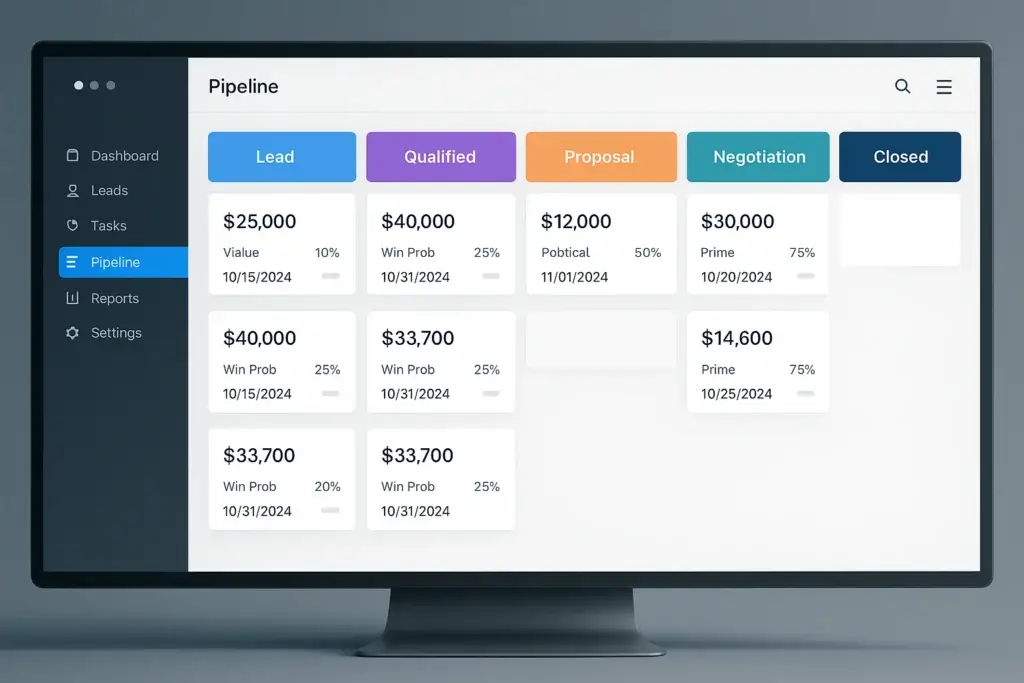
Approaches and Methods
Qualitative vs. quantitative methods
Forecasting methods fall into two broad categories:
- Qualitative methods: These rely on the knowledge and intuition of experts, sales leaders, industry analysts or customer focus groups. Techniques include the Delphi method, where experts independently submit forecasts and iterate toward consensus, and market surveys that gauge demand. Qualitative approaches are useful when historical data is scarce, such as when launching a new product or entering a new market.
- Quantitative methods: These use numerical data and statistical models. Time series analysis evaluates past sales to identify trends, cycles, and seasonality. Moving averages smooth out fluctuations to reveal underlying patterns. Regression analysis examines relationships between variables (e.g., price changes, marketing spend) and sales outcomes. Quantitative methods work best when you have ample historical data and a stable market environment.
Most businesses blend qualitative insights with quantitative analysis. For example, you might use a regression model to forecast baseline revenue and overlay insights from sales reps about upcoming enterprise deals or macroeconomic risks.
Sales funnel forecasting
Sales funnel forecasting is a straightforward quantitative method that assigns probabilities to each stage of your pipeline. For example, your CRM might show five stages: new lead, qualified lead, proposal, negotiation, and closing. You assign a potential win rate to each stage based on historical conversion rates, perhaps 10% for new leads, 25% for qualified leads, 50% for proposals, 75% for negotiations, and 90% for deals in the closing stage. To forecast revenue, you multiply the value of each deal by its stage’s probability and sum the results.
Advantages:
- It leverages data already in your CRM.
- It highlights which stages are bottlenecks, allowing managers to coach reps or adjust the sales process.
- The methodology is transparent and easy to explain to stakeholders.
Disadvantages:
- It assumes consistent conversion rates across time and sales reps. Without a well‑defined process, probabilities may be inaccurate.
- Early‑stage deals can skew forecasts if their values are high but their win probability is low.
To maximize accuracy, regularly review and update the win probabilities for each stage and ensure the sales process is clearly defined.
Lead scoring and weighted pipeline
Another approach is to forecast by lead score. Each lead source or segment receives a score based on past performance. For example, referrals might be scored as an 8.1 out of 10 due to historically high close rates, while social media leads receive a 5.4 because they convert less often. You then weight pipeline revenue by these scores and other factors, such as company size or industry. Deals with higher scores contribute more to the forecast, while lower‑scored deals have reduced impact.
Advantages:
- Removes emotion and bias from forecasting by relying on data‑driven scores.
- Encourages the sales team to focus on high‑quality leads that are more likely to close.
Disadvantages:
- Requires accurate and comprehensive data entry from sales reps. Incomplete records or inconsistent scoring can distort results.
- Only considers attributes measured in the CRM; untracked factors may affect outcomes.
Combining lead scoring with funnel stages can produce a more nuanced forecast. For instance, you might apply a stage probability and a lead score to each deal, generating a compound probability for closing.
Regression analysis
Regression analysis is a quantitative method that uses mathematical equations to model the relationship between sales and influencing variables. In the context of CRM sales forecasting, regression models might explore how deal size, time in pipeline, number of meetings or marketing spend correlate with win probability. By analyzing historical data, the model estimates coefficients for each variable. You can then apply these coefficients to active deals to predict their likelihood of closing.
Advantages:
- Provides precise, mathematical predictions and quantifies the impact of multiple factors.
- Can accommodate numerous variables and reveal complex relationships.
Disadvantages:
- Requires clean, comprehensive data; missing or inaccurate entries reduce reliability.
- More complex to set up and interpret than simpler methods. Many businesses need data analysts or specialized tools to implement regression forecasting effectively.
While regression analysis can be resource‑intensive, it offers highly accurate forecasts when implemented correctly. Modern CRMs and analytics tools may include pre‑built regression models, allowing non‑technical users to benefit from advanced forecasting.
AI and predictive analytics
Machine learning and predictive analytics have transformed sales forecasting. AI models ingest vast amounts of data, from CRM interactions to web traffic and social media engagement, and identify patterns humans might miss. Predictive analytics can automatically update probability scores, suggest win rates for each opportunity, and highlight deals at risk of slipping. AI systems may also recommend next‑best actions for reps, such as sending a follow‑up email or scheduling a call.
Benefits of AI forecasting:
- Improved accuracy: Predictive models often increase forecast accuracy by 20–30%. By analyzing thousands of variables simultaneously, they capture subtle signals that traditional methods overlook.
- Real‑time updates: As new data comes into the CRM, AI recalculates forecasts without manual intervention. This adaptability is valuable in volatile markets.
- Decision support: AI can present scenario models, best, worst, and average cases, so you can plan for a range of outcomes. It also surfaces insights such as which segments drive revenue or which reps need coaching.
Considerations:
- AI models rely on data quality. Consistent data entry and routine cleansing are essential.
- Some organizations may need to upskill staff or work with vendors to implement AI forecasting tools.
Modern CRMs increasingly include AI‑driven forecasting features, allowing even small businesses to benefit from advanced analytics without hiring data scientists.
Below is a quick comparison of the main CRM sales forecasting approaches, helping you choose the one that best fits your sales model.
| Method | Type | Key Idea | Best For | Pros | Cons |
| Qualitative Forecasting | Expert judgment | Relies on opinions from sales leaders, analysts, or customer feedback | New products or markets with little historical data | Flexible, intuitive, uses industry knowledge | Subjective, prone to bias, less data-driven |
| Quantitative Forecasting | Statistical modeling | Uses past sales data, trends, and relationships between variables | Stable markets with sufficient historical data | Data-based, objective, replicable | Needs clean, consistent data; less adaptable to change |
| Sales Funnel Forecasting | Quantitative | Assigns probabilities to each pipeline stage to project expected revenue | Teams using structured CRM pipelines | Transparent, easy to explain, highlights bottlenecks | Assumes fixed conversion rates, sensitive to inaccurate inputs |
| Lead Scoring & Weighted Pipeline | Quantitative | Scores leads or deals based on conversion likelihood and quality | Data-driven sales teams with diverse lead sources | Reduces bias, prioritizes high-quality leads | Requires consistent data entry, may miss untracked factors |
| Regression Analysis | Quantitative | Models relationships between sales and influencing variables | Data-rich organizations with analytics capabilities | Highly accurate, reveals key drivers of sales | Complex setup, needs data science expertise |
| AI & Predictive Analytics | Machine learning | Uses AI to find hidden patterns and update forecasts in real time | Teams seeking advanced, automated forecasting | High accuracy, real-time insights, scenario modeling | Dependent on data quality, may need training or vendor support |
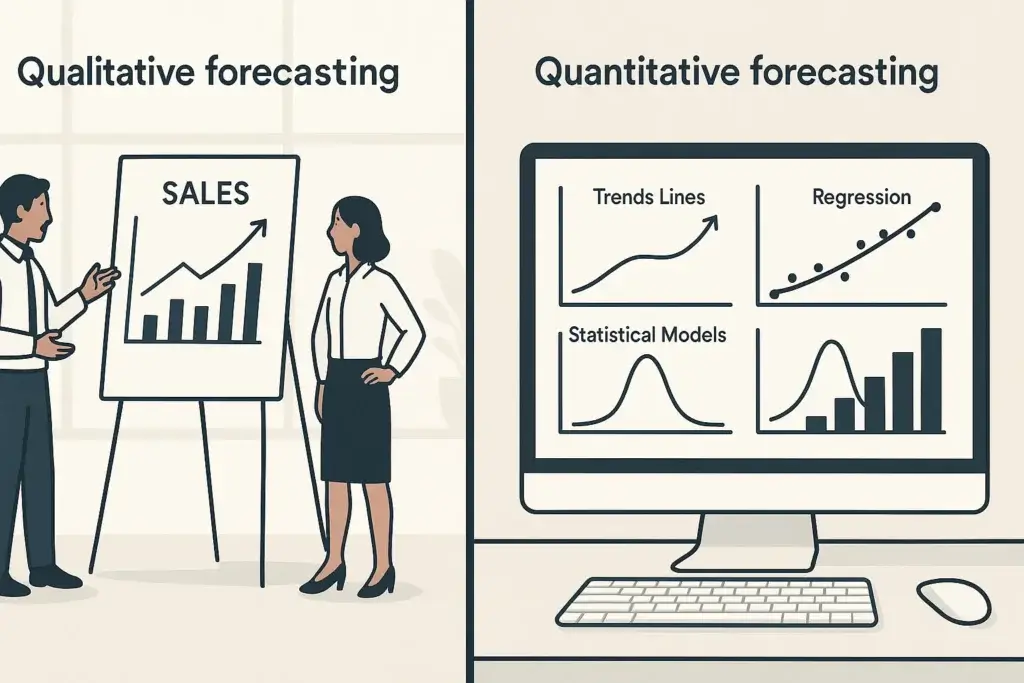
Sales Forecasting Process
Step‑by‑step guide: define goals, choose a timeframe, gather data, anticipate modifications, analyze competitors, select a method, build and share a forecast
A structured process ensures your forecast is actionable and reliable. Follow these steps:
- Define your goal: Clarify what you are forecasting and why. Are you estimating revenue for next quarter to plan inventory? Or projecting annual sales to secure funding? Purpose dictates the level of detail required.
- Choose your timeframe: Decide whether to forecast weekly, monthly, quarterly or annually. Shorter timeframes suit tactical decisions like staffing, while longer horizons inform strategic planning and investment.
- Gather your data: Consolidate relevant information, historical sales figures, CRM pipeline metrics, marketing plans, customer feedback, market research and competitor analysis. Ensure the data is accurate, consistent, and current.
- Anticipate modifications: Consider factors that may affect your forecast. Upcoming product launches, pricing changes, seasonality, economic shifts, and campaigns should all influence your assumptions.
- Study competitors: Examine competitor actions and industry trends. Price changes, new products or strategic moves can impact demand for your products.
- Select your method: Choose forecasting techniques based on available data and goals. Combine qualitative insights (expert opinions) with quantitative models (funnel probabilities, lead scoring, regression, predictive analytics) for a balanced approach.
- Build the forecast: Apply your chosen method to the data. Use your CRM or spreadsheets to calculate expected revenue. If using a weighted pipeline, multiply deal values by their probabilities. For regression or AI models, input variables into the forecasting tool.
- Analyze and share: Review the forecast to identify trends, outliers, or risks. Share findings with sales, marketing, finance, and operations. Collaboration ensures the forecast informs budgeting, staffing, and inventory planning.
Best practices: regular updates, flexibility, collaboration, and accuracy tracking
To keep forecasts relevant and trustworthy, adopt these best practices:
- Update regularly: Forecasts become outdated quickly. Review and revise them monthly or quarterly to incorporate new data and changing conditions.
- Stay flexible: Be ready to adjust your forecasting methods when market conditions shift or new information emerges. Use scenario planning to prepare for best‑case, worst‑case, and average scenarios.
- Use the right tools: Choose CRM or analytics platforms with versioning, scenario planning and collaboration capabilities. The right software simplifies data aggregation and visualization.
- Involve key teams: Engage sales, marketing, finance and operations early in the process. Shared insights lead to more accurate assumptions and foster alignment.
- Track accuracy: Compare forecasted results with actual outcomes. Analyze discrepancies to refine assumptions and improve the next forecast cycle.
A disciplined process combined with continuous learning will yield progressively more accurate forecasts.
Common Challenges and Mistakes
Data quality and availability
Forecasting depends on reliable data. Common data challenges include incomplete records, inconsistent data entry, and siloed systems. When sales reps fail to log activities, the CRM may underestimate engagement levels, leading to low probability scores. Outdated data, such as stale contact information or incorrect deal values, distorts projections. To overcome these issues, establish clear data‑entry guidelines, automate data capture where possible, and regularly clean your CRM database. Investing in data quality pays dividends in forecast accuracy.
Unpredictable market factors
Even the most precise models cannot fully predict external events. Economic downturns, supply chain disruptions, pandemics, natural disasters, or sudden shifts in consumer behavior can render forecasts obsolete. Mitigate this risk by creating multiple scenarios (optimistic, realistic and pessimistic), using shorter forecasting windows when uncertainty is high, and leveraging real‑time data feeds. Being prepared to pivot quickly ensures you stay agile when faced with volatility.
Complexity and over‑reliance on historical data
Complex forecasting models can intimidate stakeholders and obscure assumptions. Overly complicated equations or reliance on sophisticated software may erode confidence. Moreover, using historical data as the sole predictor can be misleading when market conditions shift dramatically. Simplify where possible: choose methods that stakeholders understand, and clearly document assumptions. Blend historical analysis with real‑time data, expert insights, and external indicators to produce well‑rounded forecasts.
Role of Modern CRM Tools
How CRM automates data collection and analysis
Modern CRMs streamline the forecasting process by automatically capturing data from emails, calendars, phone calls, and web forms. Activity capture tools log interactions without manual effort, ensuring that engagement metrics are complete. Workflow automations prompt sales reps to update fields when advancing a deal, improving data consistency. Built‑in analytics dashboards summarize pipeline health, deal velocity, and conversion rates, allowing managers to spot trends quickly. Some systems even integrate with accounting software to pull revenue recognition data, giving finance a real‑time view of bookings and billings.
AI‑driven capabilities and predictive insights
AI features in CRMs analyze patterns across thousands of deals to identify which factors correlate with success. Predictive scoring models assign probabilities to opportunities based on attributes such as company size, industry, engagement level, and decision‑maker responses. These models continuously learn from new data, refining predictions over time. Beyond forecasting revenue, AI can recommend next‑best actions, for example, prompting reps to re-engage a stalled prospect or suggesting cross‑sell opportunities. By surfacing at‑risk deals and prioritizing high‑value accounts, AI forecasting makes sales teams more efficient and focused.
Example table comparing CRM features
The table below compares selected features of two popular CRM platforms with respect to sales forecasting. It shows how different tools package AI capabilities, storage, support, and mobile access for revenue forecasting needs. Use it to evaluate which platform aligns best with your requirements.
| Feature Type | monday CRM | Salesforce |
| AI Capabilities | 500 credits/month included in plans | Added cost, starts at Enterprise tier |
| Storage Overage | Not specified in data | $125/month per 500MB |
| 24/7 Support | Included | +20% of license cost |
| Mobile Access | Included | Some features require +$50/user/month |
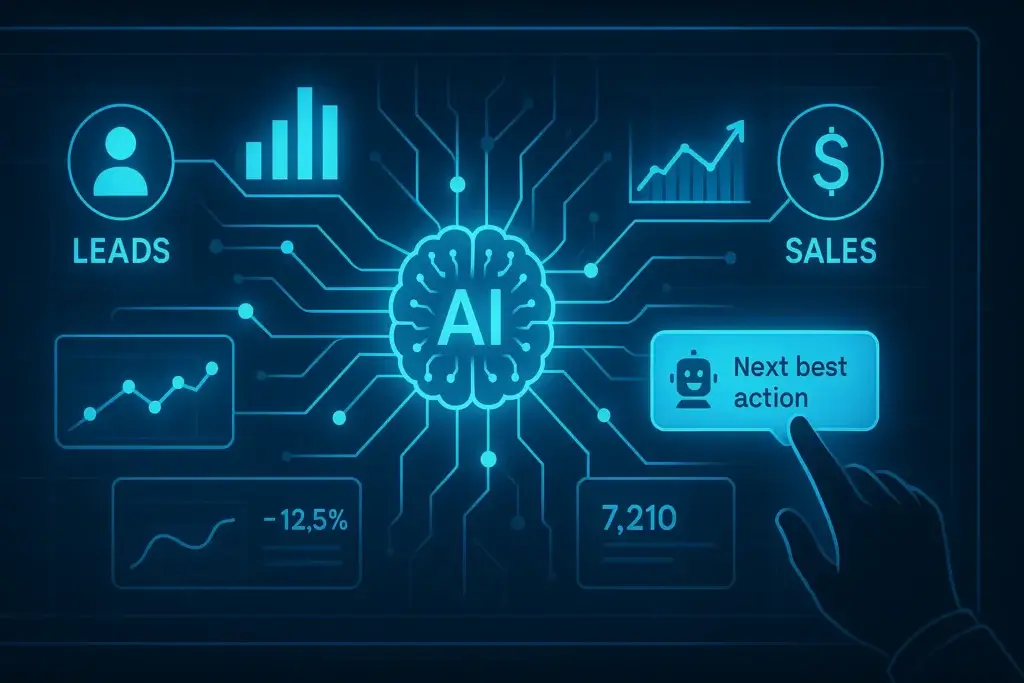
Tools Used in CRM Sales Forecasting
Modern CRM systems do more than store contacts, they empower teams to forecast sales with precision using real-time data, automation, and AI. Below are some of the best CRM tools that make sales forecasting more accurate and efficient.
| Tool | Best For | Forecasting Highlights |
| monday CRM | Customizable, visual forecasting dashboards | AI insights, pipeline views, and predictive analytics with 500 monthly AI credits included |
| HubSpot Sales Hub | Inbound sales teams | Custom forecast categories, deal stages, weighted pipeline projections |
| Pipedrive | Small businesses and sales teams | Intuitive forecast reports and deal probability scoring |
| Salesforce Sales Cloud | Enterprise-level accuracy | Advanced AI forecasts through Einstein Analytics, real-time dashboards |
| Zoho CRM | Mid-size businesses | Territory-based forecasts, quota management, and predictive scoring |
| Freshsales | Startups and fast-growing teams | AI-based deal insights and time-based forecast analysis |
| Zendesk Sell | Service-oriented teams | Simple forecasting view integrated with customer support data |
| Insightly | Project-driven sales | Pipeline forecasting linked with project delivery timelines |
monday CRM: The Top Choice for Predictive Sales Forecasting
monday CRM (Full review) stands out as the best CRM for sales forecasting due to its blend of automation, data visualization, and AI capabilities.
You can build tailored forecast dashboards by region, sales rep, or product, all synced automatically with your sales pipeline. The platform’s AI assistant analyzes pipeline health and predicts deal closure likelihood based on historical data and current activity.
💡 Ideal for teams seeking flexibility and real-time insights with visual dashboards and automation.
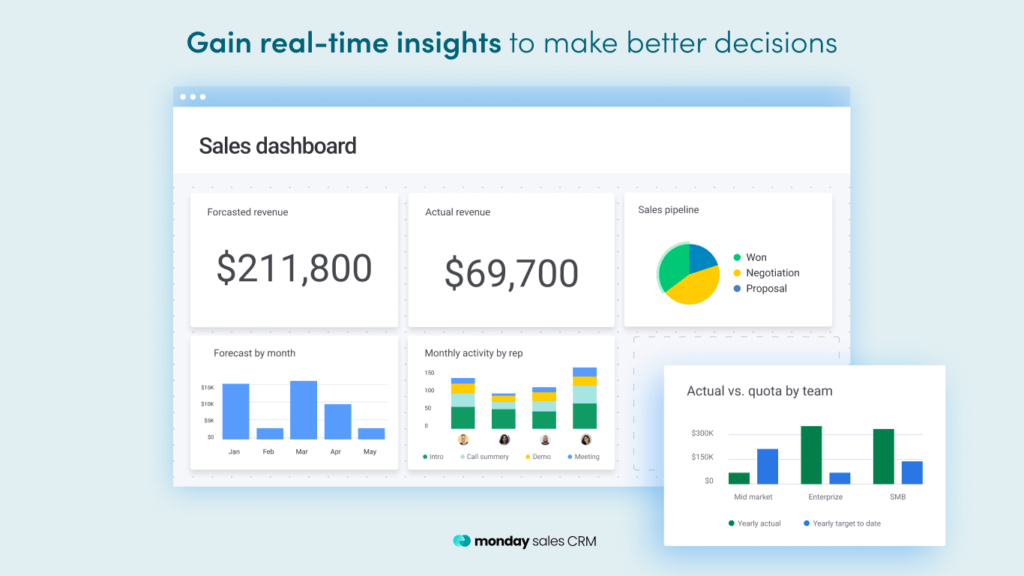
HubSpot Sales Hub
Hubspot’s (Full review) forecasting tools are perfect for inbound sales organizations. You can customize forecast categories, track quotas per rep, and use weighted pipeline forecasting for more accurate projections. Integration with its marketing CRM ensures every forecast includes the impact of inbound leads and campaign performance.
Pipedrive
Pipedrive (Full review) is known for its simple, visual forecasting tools that appeal to SMBs. The system automatically calculates the expected revenue based on deal probabilities and expected close dates. Teams can instantly see forecasted sales by user, region, or pipeline stage.
Salesforce Sales Cloud
Salesforce dominates enterprise forecasting. The Einstein Forecasting module uses AI and historical data to generate highly accurate predictions. It also includes collaboration tools that allow managers to override or adjust forecasts and instantly visualize team performance.
Zoho CRM
Zoho CRM combines automation with territory management and AI scoring. Its forecasting tools allow you to track revenue by territory, rep, or product line and use Zia AI to predict which deals are most likely to close.
Freshsales
Freshsales by Freshworks brings simplicity and AI into forecasting for startups and small teams. It provides deal stage forecasting, revenue targets, and insights based on sales velocity, helping sales leaders optimize performance month over month.
Zendesk Sell
Zendesk Sell integrates forecasting with support data, allowing businesses to understand how customer satisfaction impacts sales results. It’s ideal for service-driven organizations seeking unified customer and sales insights.
Insightly
Insightly links CRM and project management, helping teams forecast not only sales but also project capacity and delivery. This dual perspective ensures sales forecasts align with operational resources, improving reliability.
Conclusion
CRM sales forecasting is more than a spreadsheet exercise; it’s a strategic discipline that combines reliable data, structured processes, and modern analytics to illuminate the future. By leveraging your CRM’s centralized data, assigning probabilities to pipeline stages, scoring leads based on historical performance, applying regression or AI models, and regularly updating your assumptions, you can project revenue with greater confidence. Accurate forecasts empower every department, from sales and marketing to finance and operations, to plan effectively, manage risks, and seize opportunities. Implementing a robust forecasting process takes effort, but the reward is improved agility, better resource allocation, and a clearer growth path.
Frequently Asked Questions
1. What is CRM sales forecasting?
CRM sales forecasting uses data in your CRM, such as deals, customer interactions, and historical sales, to predict future revenue. Unlike manual methods, it leverages real‑time data and built‑in analytics to generate more accurate projections.
2. Why is sales forecasting important for small businesses?
Small businesses benefit from forecasting because it informs budgeting, staffing, and inventory decisions. Even without extensive historical data, you can use market research, competitor analysis, and scenario planning to create ranges and adjust as you gather more data.
3. How often should forecasts be updated?
It’s best to review and refresh your forecasts at least monthly or quarterly. In volatile markets, shorter intervals, such as weekly, help you stay responsive to rapid changes.
4. Which forecasting method is best?
No single method suits every situation. A blended approach works well: use quantitative techniques (weighted pipeline, regression) for baseline numbers and qualitative insights from sales reps or market research to adjust assumptions.
5. What data do I need for accurate forecasting?
You need historical sales figures, detailed CRM records, defined pipeline stages, quotas and data on marketing campaigns and external factors. Clean, consistent data improves the reliability of your models.
6. Can predictive analytics replace human judgment?
Predictive analytics enhances forecasting but doesn’t eliminate the need for human insight. AI models identify patterns and calculate probabilities, while sales leaders provide context about market conditions, customer relationships, and upcoming deals.
7. How does lead scoring improve forecasting accuracy?
Lead scoring weights deals based on their quality and past performance. By assigning higher scores to leads that historically convert well, forecasts reflect the true likelihood of revenue rather than treating all opportunities equally.
8. What are common pitfalls to avoid?
Avoid relying solely on historical data without considering current market conditions. Ensure your CRM data is complete and up to date, involve multiple departments in the process, and keep models simple and transparent to maintain stakeholder trust.
9. Do I need a sophisticated CRM to forecast sales?
While advanced CRMs offer AI features and automation, you can start with basic tools like spreadsheets. The key is maintaining accurate data and following a structured process. As your business grows, migrating to a CRM with built‑in forecasting capabilities can save time and improve accuracy.
10. How can I measure the accuracy of my forecasts?
Compare projected revenue with actual results over the same period. Calculate the percentage error and analyze the reasons for discrepancies. Tracking accuracy over time helps refine your methods and assumptions.




